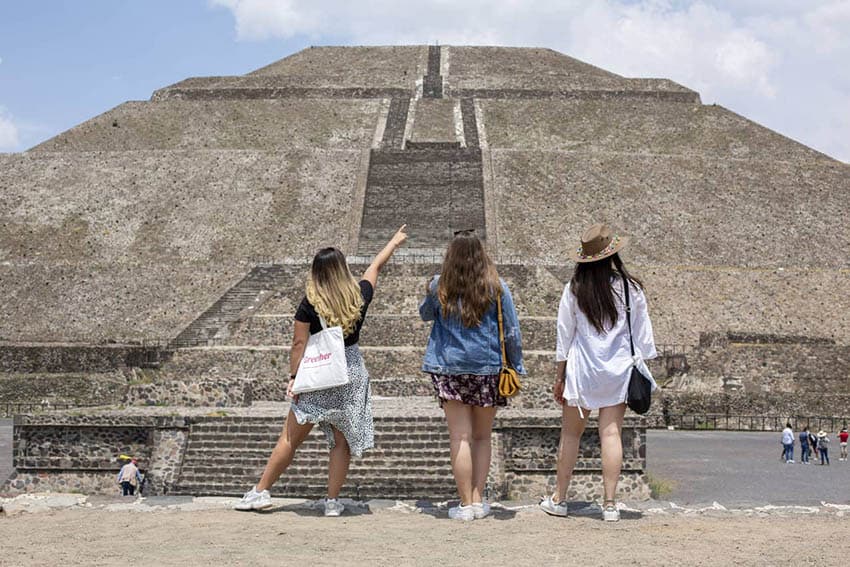
My days with the Tattooed Women, the Chin in Burma
By Natalia Vildosolia-Garcia
Once upon a time, in the remotest highlands of Burma, there was an ethnic tribe who called themselves as K’Cho, better known as Chin or face tattooed women.
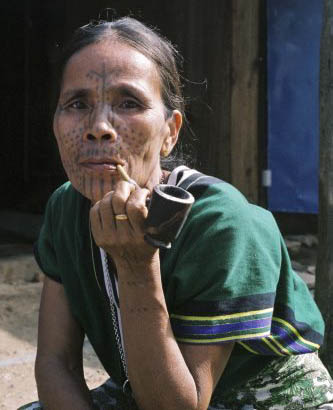
In that region, the elderly women had stretched ears and tattooed their faces according to the 11th-century tradition. So according to the popular legend, during the time of Kings in Burma, they were used to choose the most beautiful girls for their harems, and the Chin women were renowned for being the most beautiful of Burma.
Tattooing the Young Maidens
Consequently, their families decided to tattoo the faces of young maiden girls to hide the tribal women’s beauty to protect them from kidnapping. It seems like a forgotten story from past times, except is related in present times.
Because of this, this tradition was maintained since ancient times until the 1960s when the practice was banned, even though some were still practicing until the last tattoo was inked in 1998.
Mutilated to Avoid Slavery
In some way, these women have been mutilated in the name of protection from slavery, but some of them told us that after being inked they could not eat for some days because of swelling in the face, they said that was absolutely painful but despite this, they were proud because of their tradition.

Getting there
So starting the day very early in the morning, just to find the bus station in Pakkoku was a challenge, in this “jungle town” nobody spoke English and I didn’t have any map to find the right location because it was not the same place where I was dropped off the night before.
After all, I finally found the right station and from there, there was a minivan that was going to Mindat every morning around 8:30 am, but mine was half an hour late.
The only access to that deep mountain town was through this jungle town, and it was only possible to reach it during the dry season.
Rainy Season Delays
During the rainy season, it is not possible to go across some streams which do not have bridges. Fortunately, since 2013 you do not need a special permit to visit Chin State, but even that you still need to show your passport at the border.
During the journey that takes around six hours with one stop for lunch, when I was approaching this area I saw how the tropical palm trees gave way to the tall pine trees lining the road while the distant blueness of the mountains was getting close.
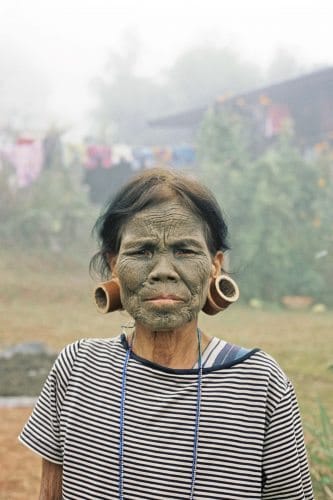
I felt how the humid heat and sticky air were becoming more and more fresh and pure, a rare sensation after spending four months under the heat of South East Asia’s burning sun.
Even the expected long bumpy bus ride on a narrow, winding road going up, the journey was a wonderful vision of that scenery.
Meeting the Tattooed Women
As soon as I entered the village, I began to see the faces I had come to see. Walking through the village searching for a place to stay the next two nights, I crossed some impressive elderly face-tattooed women.
Baskets and Knives for the Market
These women were carrying baskets and knives to put up for sale at the market, while some men were bringing along handmade shotguns on the streets, locals were still wearing Chin traditional dresses on and wore beautiful necklaces while some old women still had on enormous Chin traditional earrings.
In the market is where all interesting local life and culture were going on.
In this isolated environment with no internet or wifi at all, the accommodations were limited in this remote town. I was staying at Tun guesthouse–located 10 minutes’ walk from the market- where the room was very simple and with a strong musty smell, obviously with the bathroom outside, in contrast, I could see the hills from my room.
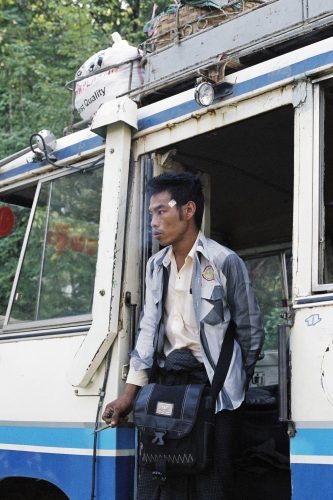
The plan was to go to the market to find something to eat but on my way I stopped and stared astonished at the delightful colors reflected on the enclosing peaks along with the twilight fog ascended from the silent blue confining mountains, falling in the village at dusk until the first rays of the sun when the peaks will be light up again.
Some Have Generators
All at once, the locals light themselves with candles and flashlights and just a few bars and Guest House produce their own electricity by generators.
Randomly, I met two girls that I had already met in a hostel in Mandalay, so we went together for dinner to a local restaurant where no one could speak English but the menu was only in Burmese; we ordered boiled rice with vegetables and apparently, chicken.
These girls gave me some good tips for the next day about how to get a moto-driver guide speaking in English, otherwise, I would totally miss the interesting things, also they warned me that five minutes before 22 the lights start to flicker just to announce the imminent complete darkness. Afterward, the stars began to twinkle firmly.
Cold Showers
Deep in the mountains, life commences with the roosters crowing. I ran for my morning shower but when I opened the tap for water, ice cubes came out so I decided to not take a proper wash for the next two days. The weather was too cold here, especially at night and at dawn.
Local Life in the Village
After contemplating this spectacular landscape, pretty high in altitude, around 2000 meters, I went directly to the upper city for my instant morning coffee and breakfast in a small shop in front of the market, which was the best place to meet people and observe local life.
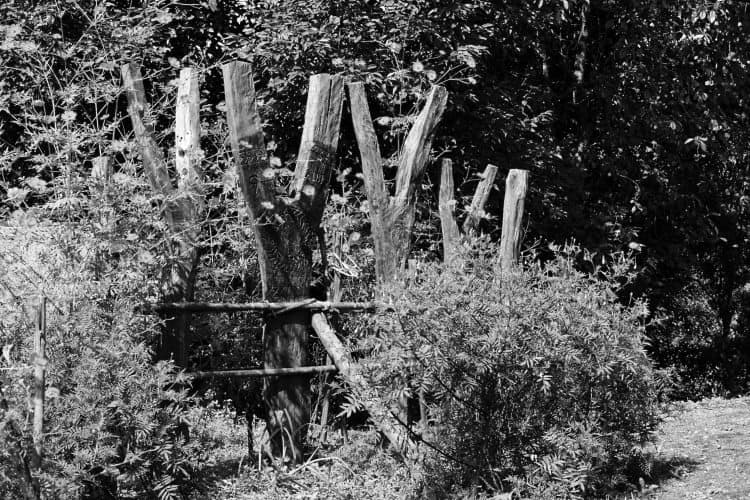
They were constantly coming and going with their big baskets. The way K’cho people earn a living is by practicing shifting cultivation, trapping, hunting, and logging.
I came across some of them very close and I could see the different patterns of their tattoos because the K’cho minority -only in Mindat and Kanpetlet- is divided into three main tribes; Munn, Dai and Making. Which are distinguished by different facial design tattoos.
Munn women have a series of small circles, making a half-moon shape on the cheeks, while Makang’s tattoo has dots all over the face, and Dai women have their entire faces covered in dots, you can not even see the color of the skin.
Nowadays, this tradition is dying. When these people die, this ritual will die with them. That was the main reason I came, to admire these captivating faces.

You can find some Catholic churches around here. In the animistic culture, they are worshiping the “Nats” –the spirits– so in every Chin village they make animal sacrifices outside the houses at least once during their lives and they are showing their sacrifices by hanging the skulls on the facade of their houses and also marking in a wooden animist totem pole how many animal sacrifices have been made in the family.
February the Best Time
The best time to see the rites of Chin culture is during their festival that takes place once a year in February.

In the animistic culture, they are worshiping the “Nats” -the spirits- so in every Chin village they make animal sacrifices outside the houses at least once during their lives and they are showing their sacrifices hanging the skulls on the facade of their houses and also marking in a wooden animist totem pole how many animal sacrifices were made in the family.
The best time to see the rites of Chin culture is during their festival that takes place once a year in February.
The next morning I woke up with the first sunshine and saw this foggy light slipping between the blue curves of the bordering mountains and listening to the distance people praying, was a splendid way to conclude my small adventure in these hills of one of the remotest parts of genuine Burma.

Natalia Vildosolia-Garcia is a freelance Interior Architect and Photographer based in Barcelona.
- Saudi Arabia Might Be Your Next Getaway Spot - April 23, 2024
- Mongolia, the Land of Eternal Blue Sky - April 20, 2024
- These 9 U.S. National Parks Require Reservations in 2024 - April 17, 2024



